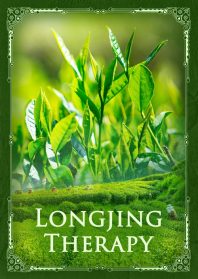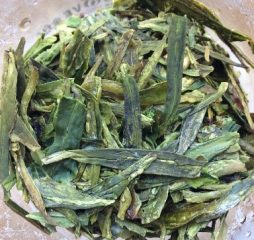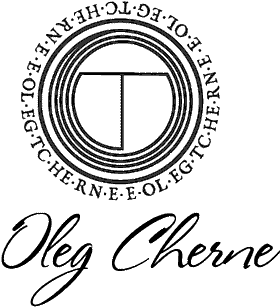Longjing Therapy

Longjing therapy presents us with one of the most valuable and unique teas – the King of green teas, Longjing. The name of this tea translates as Dragon Well. The historical center of its cultivation is the village of the same name, which is part of the Hangzhou urban district (Zhejiang Province). It is this tea that has been given the status of “imperial tea”. And the strongest old bushes are valued as a precious treasure.
The history of this tea goes back thousands of years and is surrounded by myths and legends. But its main secret lies in the special climate of the local hills and in the power of the soil filled with miraculous power that goes into the tea leaf. In fact, Longjing becomes a tea not just because of the place of origin, but because of the whole technological chain, which imposes special requirements on the following criteria:
- Place of growth
- Gathering period
- Drying
- Brewing
- Consumption
- Storage
If we are really interested in the therapeutic benefits of this miraculous tea, it is important for us to consider all these factors, because there are no trifles in the consumption of royal Longjing tea. And in order to get a subtle taste with toning fresh spring notes and emerald color to enjoy the magical flavor at the end, it is important to comply with all conditions.
Growing Area
For the best quality tea, the growing area with its special microclimate that feeds the tea leaf is extremely important. This happens both due to the root (and here the age of the bush is very important) and due to the characteristics of the space (the influence of the tea fog) where it is grown.
The area around West Xihu Lake in Hangzhou City District (Zhejiang Province) is considered optimal. The area of the lake is a UNESCO World Heritage Site with its unique ecosystem and cultural heritage of ancient pagodas and temples. It is the place that is considered optimal for the cultivation of Longjing tea.
- Royal Longjing. The highest and most valuable grade. Grows on Mount Shifeng west of Xihu Lake. The mountain has a beautiful view of the lake, tea plantations, and Hangzhou city.
- Cloudy Yunqi.
- Mei Jia. A kingdom of tea plantations in one of the ravines near the village of Meijiau at the foot of Mount Shifeng.
- Hu Pao. The area of cultivation is south of Huzhou.
The tea is further classified according to the harvesting period. Tea that is harvested before the Qingming Festival (Clean Light Day) is called Mingxiangcha. This tea is considered the strongest and tastiest, while leaves harvested after the holiday (which traditionally falls in early April) are of second-grade quality. Also important is the age of the bush, which shows the degree of mineralization.
It is worth bearing in mind that there are currently 18 officially recognized places where the tea grown is allowed to be called Longjing, with the list growing in size due to demand. There are hundreds of uncontrolled places, where grass, in fact, can be sold under the guise of Longjing. Even in recognized regions, tea of sufficient quality is seriously inferior to the true Longjing from Xihu.
Gathering
The first and most valuable tea is harvested in spring, even before the Qingming Festival in early April. All other tea pickings that occur after the Qingming Festival are thought to be inferior in quality, and here the age of the bush and the actual location of cultivation are the issues.
The real criteria for evaluating the collection period are quite demanding and involve collecting within three days while the buds are infused with potency. Such tea doesn’t even make it to the counter, as it is sorted beforehand by specialists and tea lovers or simply by those who have enough money to buy this tea.
Much depends on the weather and the quality of the harvest (it is important to pick by hand). The result is that the most valuable tea is made from buds. Next on the scale of value are the small, barely opened buds, then the leaf, and then the larger leaves, which often resemble grass.
But even if you have good quality and correctly harvested raw material, this is still half the battle – what follows is the important process of tea preparation, which begins with drying.
Drying
After harvesting, it is important to treat the leaves appropriately. Tea leaves are roasted immediately after harvesting, securing the fermentation process. Roasting is done by a special method, and its performance is a special art, requiring the ability to place the leaves in a hot pot. Various manipulations have to be done in the process, including laying out the leaves, stirring, turning over, pinching, shaking, clamping, pressing, and pulling up the leaf. As a result, the leaves are given a characteristic dried flat shape.
All of these manipulations affect the quality of the tea, so it takes skill to perform them. The color of the tea becomes clear, and the leaves look perfectly stacked, even smoothed.

Brewing and Consumption
The brewing process requires a special art, during which it is important to reveal the aroma and flavor of the tea and get the emerald color of the infusion. The right water is very important for Longjing. It should be brewed at 70 degrees Celsius.
Much depends on the quality of tea. The better it is, the more options you have to interact with it. In general, the very concept of brewing Longjing is not quite correct. It is a process of absorption, revealing the power and, if you like, animating the tea leaf, which starts moving like a dragon. All actions require the ability to read the process. And here, of course, it is advisable to start an introduction to tea together with a master of the tea ceremony.
Pay sufficient attention to the process. This tea is not for the kitchen with mugs and serviettes. It requires special tea utensils and cups. Choose porcelain or glass Gaiwan, a glass teapot, and low cups to enjoy the aroma and color. Quality water, preferably spring water, is important for the unfolding of the tea. The process of preparing the Longjing itself is comparable to the practice of qigong.
The first brew is important to drain, it rinses and awakens the tea. The next one depends on the strength of the tea and can last from 3 to 15 seconds. And then it goes on incrementally. Royal Longjing can be brewed up to 15 times. If brewing in a Gaiwan, 5 grams of high-quality tea is enough for 10-15 brewings. Medium quality tea can be brewed 5 to 7 times. Everything else, however, requires no ceremonialism.
Therapy. Useful Properties of Longjing
Unleashing all the features and power of Longjing depends on the art of taking it and, of course, the quality of the tea. An important aspect is the state of the body and the perception of tea. Tea contains a whole spectrum of vitamins and amino acids. It has a high concentration of catechins (compounds that are strong antioxidants).
If we consider Longjing as an independent product (without combining it with any food), its main positive properties are as follows:
- Tones and soothes
- Forms a harmonious state and mood
- Has a good cleansing effect
- Flushes out the toxins from the body
- Strengthens the energy resource
- Nourishes the brain
- Nourishes the internal organs
- Strengthens the body’s defenses
- Rejuvenates and regenerates cells
- Strengthens vision
- Oral hygiene
Longjing is a special tea, and if we talk about it from the perspective of therapy, its effect is primarily aimed at internal regulation and strengthening of the brain. It is important to relate interaction with it to the concept of nutritional yoga. When taking it, it is important to accumulate energy both in the process of preparation and in direct consumption. The ideal time of taking it is in the morning.
Caution!
It is recommended to buy tea only through tea masters. It is a mistake to take Longjing tea only by its name. It is not easy to understand this tea, nowadays it requires time and a lot of money. And remember the problem of fakes, which began to appear because of the high demand for the variety. The most difficult thing is to find tea from a region that corresponds to the origin of Longjing.
Storage
High-quality Longjing retains its potency for up to a year if stored properly. It is advisable to store it in the refrigerator, making sure that the tea is well sealed against the influence of other smells and is not damaged by condensation during such storage.







